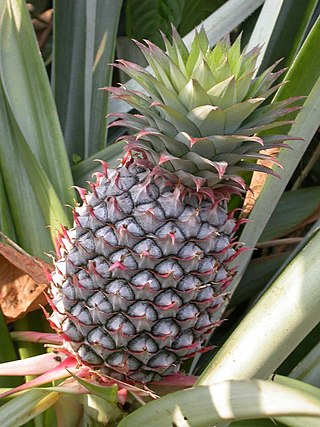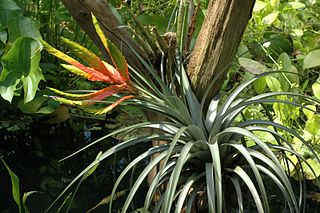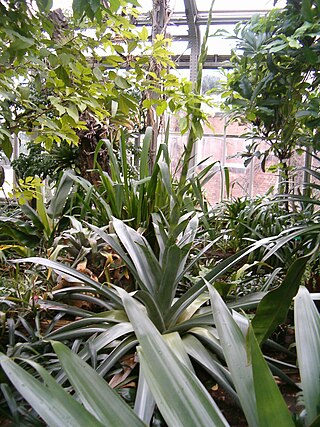
The Bromeliaceae are a family of monocot flowering plants of about 80 genera and 3700 known species, native mainly to the tropical Americas, with several species found in the American subtropics and one in tropical west Africa, Pitcairnia feliciana.
Brocchinia uaipanensis is a species of bromeliad endemic to southern Venezuela. It has been treated as the sole species in the genus Ayensua under the synonym Ayensua uaipanensis, but Ayensua is now included in Brocchinia. The species was first described in 1957 by Bassett Maguire as Barbacenia uaipanensis.

Bromelioideae is a subfamily of the bromeliads (Bromeliaceae). This subfamily is the most diverse, represented by the greatest number of genera with about 40. Most of the plants in this group are epiphytes, though some have evolved in, or will adapt to, terrestrial conditions. This subfamily features the most plant types which are commonly cultivated by people, including the pineapple.

Tillandsioideae is a subfamily of plants in the bromeliad family Bromeliaceae. This subfamily contains the greatest number of species. Most are epiphytic or lithophytic, growing in trees or on rocks where they absorb water and nutrients from the air. Spanish moss of the genus Tillandsia is a well-known species. Bromeliads in the genera Guzmania and Vriesea are the more commonly cultivated members of this subfamily.
Quesnelia blanda is a species of flowering plant in the family Bromeliaceae, endemic to southeastern Brazil. It was first described in 1856 as Bromelia blanda. As of November 2022, the Encyclopaedia of Bromeliads listed it under the synonym Quesnelia strobilospica, which it spelt Quesnelia strobilispica.
Vriesea warmingii is a species of flowering plant in the family Bromeliaceae, endemic to Brazil. As of November 2022, the species was accepted by the Encyclopaedia of Bromeliads, but regarded as a synonym of Vriesea ensiformis by Plants of the World Online.
Tillandsia rohdenardinii is a species of flowering plant in the family Bromeliaceae, native to south Brazil. It was first described by Teresia Strehl in 2004.

Pseudalcantarea grandis, synonym Tillandsia grandis, is a species of flowering plant in the family Bromeliaceae. This species is native to Mexico, Guatemala, and Honduras.
Mezobromelia pleiosticha is a species of flowering plant in the family Bromeliaceae. This species is native to northwestern South America.
Josemania truncata is a species of flowering plant in the family Bromeliaceae, native to Colombia and Ecuador. It was first described by Lyman Bradford Smith in 1954 as Tillandsia truncata. Plants of the World Online sinks the genus Josemania into Cipuropsis, treating this species as Cipuropsis truncata.
Josemania asplundii, synonym Tillandsia asplundii, is a species in the genus Josemania, native to Ecuador and Peru. It was first acquired by the 1842 United States Expedition in South America.
Josemania singularis, synonym Cipuropsis singularis, is a species of flowering plant in the family Bromeliaceae. This species is native to Costa Rica and Panama.
Cipuropsis is a genus of flowering plant in the family Bromeliaceae, native to the Caribbean, southern Central America and northwestern South America. The genus was first described by Ule in 1907.

Pseudalcantarea is a genus of flowering plants belonging to the family Bromeliaceae. Its native range is Mexico to Central America. It was first described as the subgenus Pseudalcantarea of Tillandsia before being raised to a full genus in 2016.
Josemania is a genus of flowering plant in the family Bromeliaceae, first described in 2016.
Josemania delicatula, synonym Cipuropsis delicatula, is a species in the family Bromeliaceae, native to Colombia.
Josemania pinnata, synonym Cipuropsis pinnata, is a species in the family Bromeliaceae, native to Panama, Colombia and Ecuador.
Mezobromelia magdalenae, synonym Cipuropsis magdalenae, is a species of flowering plant in the family Bromeliaceae, native to Colombia. It was first described by Lyman Bradford Smith in 1963 as Vriesea magdalenae.
Pseudalcantarea macropetala, synonym Tillandsia macropetala, is a species of flowering plant in the family Bromeliaceae, native to central and southern Mexico. It was first described by Heinrich Wawra von Fernsee in 1887 as Platystachys viridiflora.
Gregbrownia hutchisonii is a species of flowering plant in the family Bromeliaceae, native to northern Peru. It was first described by Lyman Bradford Smith in 1966 as Tillandsia hutchisonii.





